Removal Procedure
Tools Required
| • | J 24402-A Glass
Sealant (Cold Knife) Remover |
| • | J 39032 Stationary
Glass Removal Tool |
| • | GM Adhesive Caulking Kit P/N 12346392 or equivalent |
| • | Cartridge-type caulking gun |
| • | Commercial-type utility knife |
Caution: When working with any type of glass or sheet metal with exposed or rough
edges, wear approved safety glasses and gloves in order to reduce
the chance of personal injury.
Caution: Failure to prep the area prior to the application of primer
may cause insufficient bonding of urethane adhesive. Insufficient bonding
of urethane adhesive may allow unrestrained occupants to be ejected from
the vehicle resulting in personal injury.
Caution: At least 24 hours are required for complete curing of repair
material. The repair area should not be physically distrubed until after that
time. Insufficient curing of urethane adhesive may allow unrestrained occupants
to be ejected from the vehicle resulting in personal injury.
Caution: When replacing stationary windows, use Urethane Adhesive Kit GM P/N 12346392
(Canadian P/N 10952983), or a urethane adhesive system meeting GM Specification
GM3651G, to maintain original installation integrity. Failure to use the urethane
adhesive kit will result in poor retention of the window which may allow unrestrained
occupants to be ejected from the vehicle resulting in personal injury.

- Apply masking tape to
the area around the rear window in order to protect the painted surfaces,
the headliner, and as an aid in cleanup after installation.
- Open the rear compartment in order to access the reveal molding.
- Remove the reveal molding.
Grasp the edge of the reveal molding and pull the molding from the window.
- Remove the rear sail panels. Refer to
Sail Panel Replacement
in Interior Trim.

- Disconnect the rear window
defogger electrical connectors.
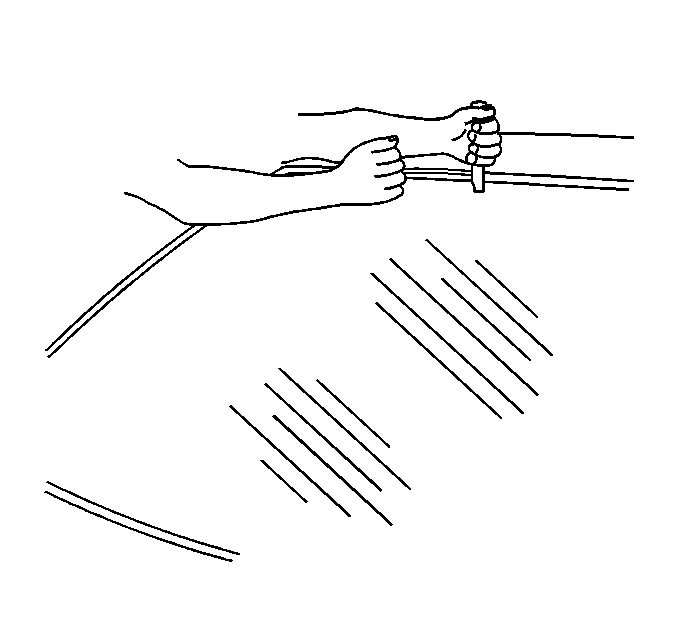
- Use J 24402-A
or J 39032
in order to cut the window from the pinchweld flange. Do this
from inside the vehicle to protect the outer surface of the paint.
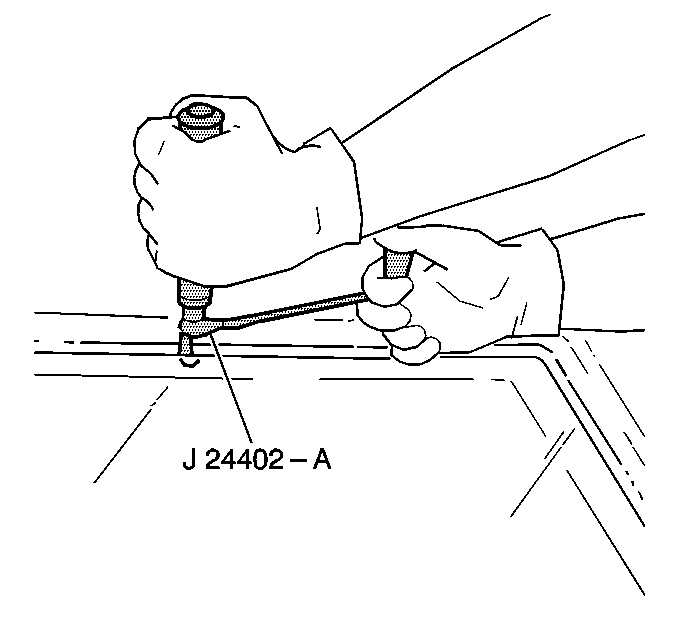
- When cutting out the glass,
apply a spray mist of water around the inner surface to aid in the removal.
Keep the blade of the knife as close to the pinchweld flange as possible
in order to leave a base of urethane on the window.
- The stationary window reveal molding retains the urethane adhesive
in the cavity between the body and the opening. If the stationary window reveal
molding is damaged by cutting the molding too close to the window surface,
replace the window.
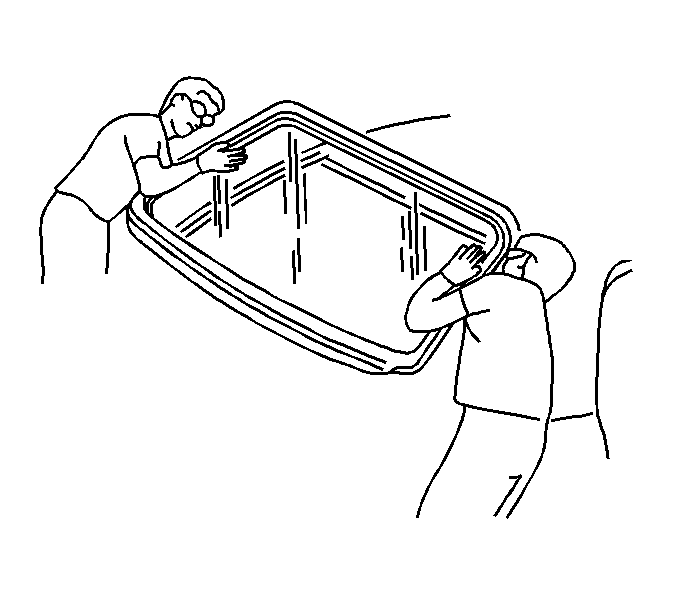
- Remove the stationary
window from the pinchweld flange with the aid of an assistant.
- Inspect the condition of the stationary window opening and the
urethane adhesive bead to determine which installation method to use. Refer
to
Short Method Description
or
Extended Method Description
for the guidelines.
- Look for any of the following conditions in order to help prevent
future breakage of the window:
| • | Hardened spot weld sealer |
| • | Any obstruction or irregularity in the pinchweld flange |
Important: If corrosion of the pinchweld flange is present, or if sheet metal repairs
or replacements are necessary, refinish the pinchweld flange in order to present
a clean primer only surface. If paint repairs are required,
mask the flange bonding area prior to the application of
the color coat in order to provide a clean primer only surface.
Use material such as BASF DE17®, DuPont 2610®, products
which are approved for this application.
- After repairing the opening as indicated, perform the following steps:
| 12.1. | Remove no more of the window urethane adhesive than necessary
in order to maintain the original shape. This will ensure proper clearance
between the window and the pinchweld flange of the opening. |
| 12.2. | Clean the rear window and pinchweld flange with a clean, lint
free cloth using GM Glass Cleaner P/N 1050427 or isopropyl alcohol
in order to clean the surface of the rear window and the pinchweld
flange. |
Installation Procedure
- After repairing the opening as indicated, perform the following:
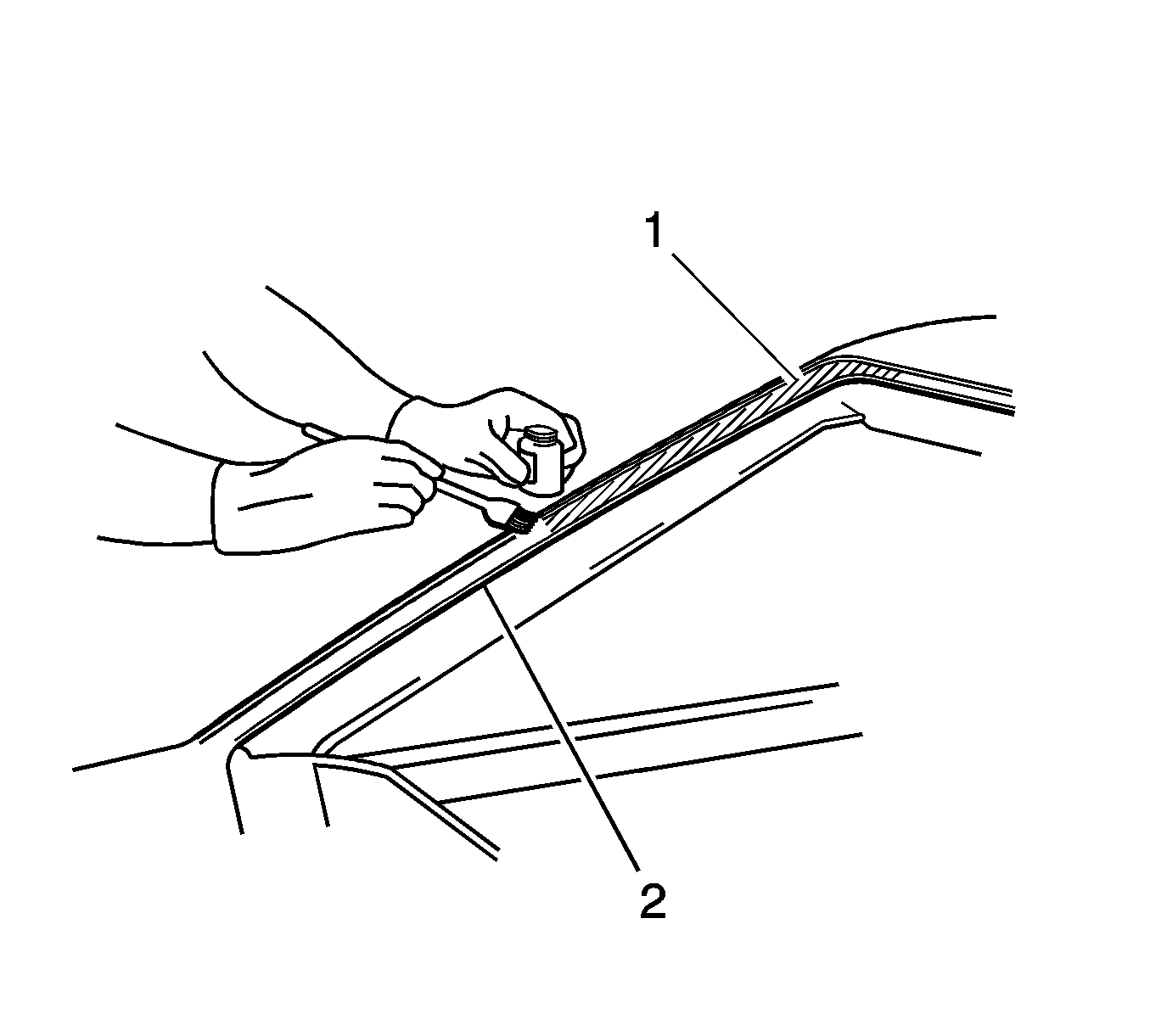
- Thoroughly shake the pinchweld primer (#3 black) well.
- Use a new dauber to apply the primer (#1) to the primed
surface of the flange in the bonding area.
- Allow the primer to dry for approximately 10 minutes.
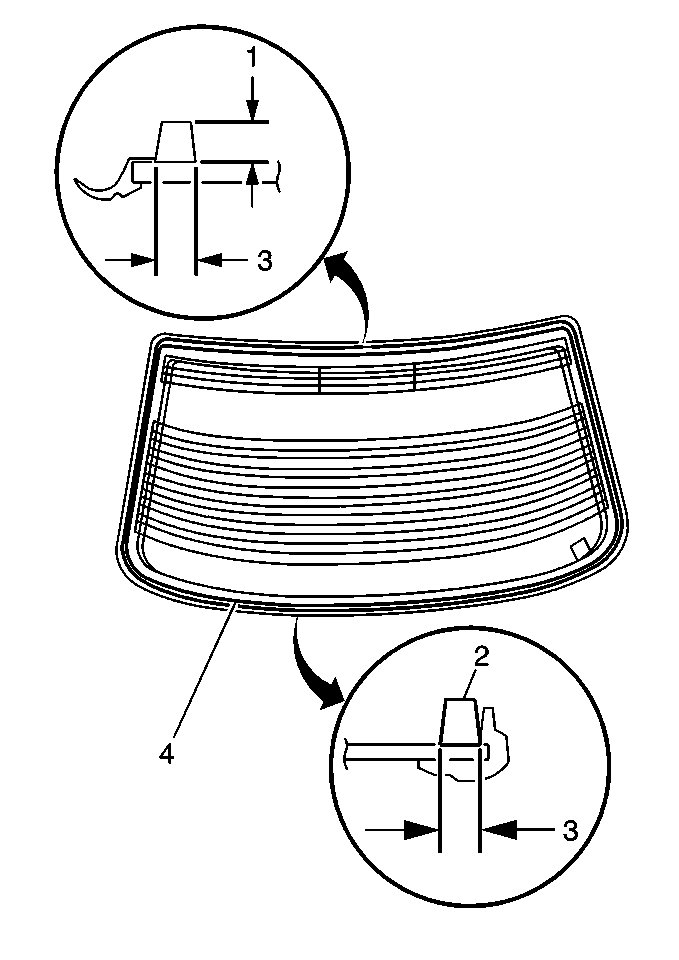
- Install a new rear window
reveal molding.
Start from the center and hand press the rear window reveal molding
onto the rear window.

- With the aid of an assistant,
dry fit the stationary window in the opening in order to determine the correct
way to position the stationary window in the opening.
- Use masking tape in order to mark the location of the stationary
window in the opening.
- Slit the masking tape at the top edge of the rear window.

- With the aid of an assistant
remove the rear window from the opening.
- Place the rear window inside up on a clean, protected surface.
- If you reuse the rear window, remove all but approximately 2 mm
(3/64 in) of the existing urethane adhesive from the rear window surface,
using a utility knife or equivalent.
- Clean the inside surface of the rear window to which urethane
adhesive will be applied (around the edge of the inside surface) by wiping
with a clean cloth dampened with GM Glass Cleaner P/N 1050427
or equivalent.
- Allow to air dry.
- If the extended installation method is being performed do the
following:
| 13.1. | Remove all but approximately 2 mm (3/64 in) of the
existing bead of adhesive from the pinchweld flange. |
| 13.2. | Do not remove all the traces of the urethane adhesive, but all
mounds or loose pieces should be removed. |
| 13.3. | Shake the pinchweld primer (#3 black) well. |
| 13.4. | Use a new dauber in order to apply the pinchweld primer to the
primed surface of the flange in the bonding area. |
| 13.5. | Allow the primer to dry for approximately 10 minutes. |
Important: Use the following procedure:
- Use care when applying the stationary window prep (#1 clear) in order
to prevent the stationary window prep from running into the vision area of
the rear window. This stationary window prep may stain the
viewing area of the rear window if not applied evenly.
This stationary window prep dries almost instantly.

- If installing a new non encapsulated window:
| 15.1. | Use a new dauber, apply the stationary window prep (#1 clear)
to an area approximately 10 to 16 mm (0.375 to 0.625 in)
around the entire perimeter of the rear window inner surface
and to any exposed edges of the rear window (reference the illustration
of the primer/bonding areas. |
| 15.2. | Immediately wipe the primed area with a clean lint free cloth. |
- If installing a new encapsulated window:
| 16.1. | Use a new dauber, in order to apply the window prep (#4
clear) to the area approximately 10 mm to 16 mm (3/8 in
to 5/8 in) around the entire perimeter of the glass inner surface
of the primer/bonding areas. |
| 16.2. | Shake the stationary window primer (#2 black) well. |
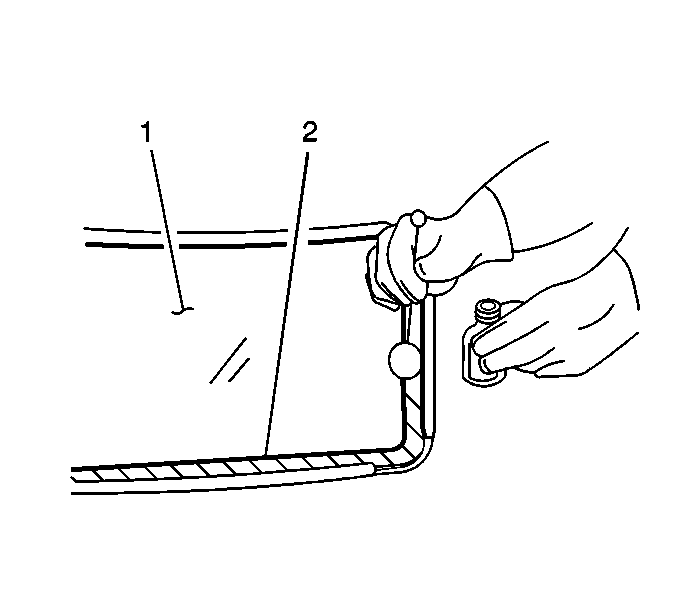
- Use a new dauber, in order
to apply the stationary window primer (#2 black) to the areas of the stationary
window (1) to which prep (#1 clear) was applied.
- Allow the primer to dry for approximately 10 minutes.
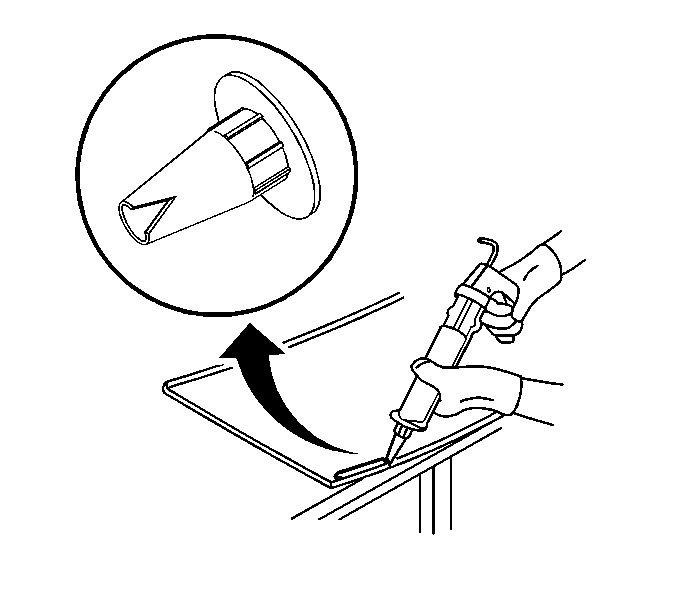
- Cut the tip of the applicator
nozzle as follows
| • | Cut the nozzle tip to provide an urethane adhesive bead of approximately
6.0 mm (0.25 in) when using the short method). |
| • | Cut the nozzle to provide an adhesive bead of approximately 10.5 mm
(0.14 in) wide and 10.5 mm (0.14 in) high when using
the extended method. |
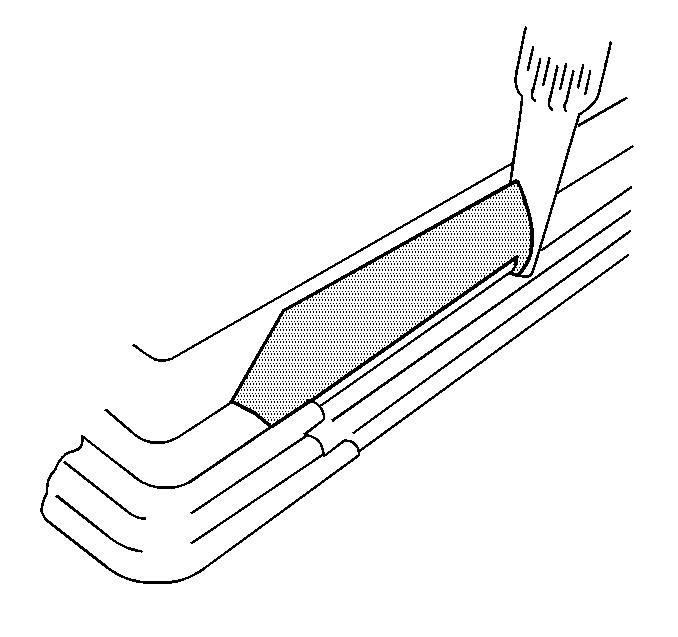
- Use a cartridge-type caulking
gun, apply a smooth continuous bead of urethane adhesive around the edge of
the stationary window where the primer was applied.
- When using the short method, apply the urethane adhesive to the
existing bead of urethane adhesive on the body.
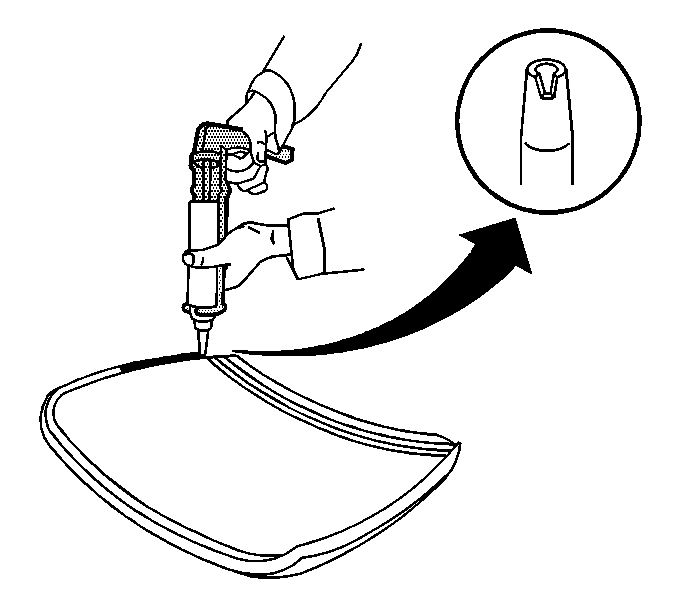
- When using the extended
method, use the edge of the stationary window or the inside edge of
the reveal molding as a guide for the nozzle in order to apply
the urethane adhesive (2) to the inner surface of the stationary
window (3).

- With the aid of an assistant,
use the suction cups in order to install the rear window into
the opening.
- Align the tape on the rear window and on the body.
- Press the rear window firmly into place to wet-out and seat the
urethane adhesive.
- Tape the rear window to the body in order to minimize movement
until the urethane adhesive cures.
- Remove any excess urethane adhesive that may have squeezed out
from the body.
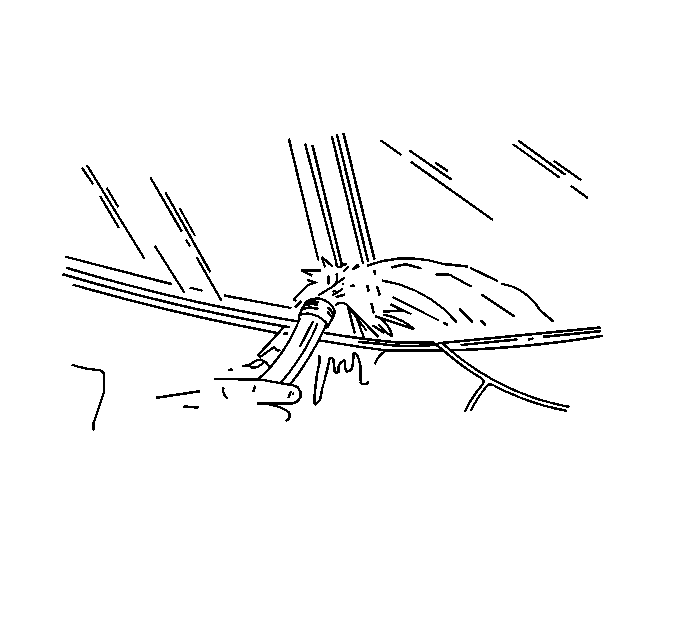
Important: Warm or hot water accelerates the cure of the adhesive. Do not direct
a hard stream of high pressure water at the fresh urethane adhesive.
- Use a soft spray of warm water in order to immediately water test the
rear window.
- Inspect the rear window for leaks.
- If you found any leaks, use a plastic paddle in order to apply
extra urethane at the leak point.
- Retest the stationary window for leaks.
- Complete the following steps in order to properly cure the urethane
adhesive:
| • | Keep the vehicle at a room temperature of 21° C (70° F)
at 30 percent or less relative humidity. |
| • | Allow a minimum of (6 hours) for the moisture curing urethane
adhesive. |
| • | Allow a minimum of (1 to 1/½ hours) for the chemical
curing of the urethane adhesive. |
| • | Partially lower a door window in order to prevent pressure build-ups
when you close doors prior to the urethane adhesive cure. |
| • | Do not drive the vehicle until the urethane adhesive is cured. |
| • | Do not use compressed air in order to dry the urethane adhesive. |

- Connect the rear window
defogger electrical connectors.

- Install the rear sail
panels. Refer to
Sail Panel Replacement
in Interior Trim.
- Close the rear compartment lid.
- Remove the tape from the painted surfaces.
- Wipe the rear window area with a clean, dampened cloth using GM
Glass Cleaner P/N 1050427 or isopropyl alcohol in order to clean
the surface of the stationary window.
- Allow to air dry.


















